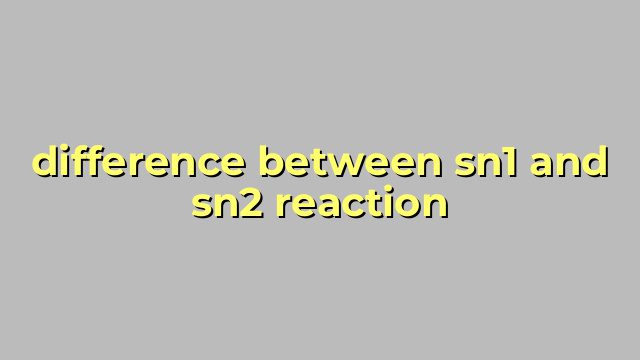Difference Between SN1 and SN2 Reactions Explained
Organic chemistry is a fascinating subject that deals with the study of carbon compounds and their reactions. One of the essential topics in organic chemistry is nucleophilic substitution (SN) reactions. A nucleophilic substitution reaction is a chemical reaction where an electron-rich nucleophile replaces another group or atom in a molecule. There are two primary types of SN reactions, SN1 and SN2, which differ significantly in their reaction mechanism and stereochemistry. Understanding the differences between SN1 and SN2 reactions is crucial in predicting the products of a reaction and designing new synthesis routes.
SN1 Reaction
SN1 reactions are unimolecular nucleophilic substitution reactions that proceed in two steps. In the first step, the leaving group departs from the molecule, leaving behind a carbocation intermediate. Carbocation is a positively charged carbon atom that is electron-deficient and highly reactive. The carbocation intermediate is stabilized by adjacent electron-donating groups or through resonance. In the second step, a nucleophile attacks the electrophilic carbon atom of the intermediate to form a new bond, resulting in the substitution of the leaving group.
SN1 reactions are characterized by their slow kinetics and require polar protic solvents like water or alcohol. The reaction rate is dependent only on the concentration of the substrate and not on the nucleophile’s concentration. SN1 reactions are primarily observed in tertiary alkyl halides or in substrates having electron-withdrawing groups, which stabilize the carbocation intermediate.
SN2 Reaction
SN2 reactions are bimolecular nucleophilic substitution reactions that proceed in a single concerted step. In this reaction, the nucleophile attacks the electrophilic carbon atom of the substrate simultaneously as the leaving group departs from the molecule. The reaction is characterized by its fast kinetics and requires polar aprotic solvents like dimethyl sulfoxide (DMSO) or acetone. The reaction rate depends on both the concentration of the substrate and the nucleophile.
SN2 reactions are primarily observed in primary or secondary alkyl halides or in substrates having electron-donating groups, which destabilize the transition state of the reaction. SN2 reactions are stereospecific, meaning that the configuration of the substrate is inverted during the reaction.
Conclusion
In conclusion, SN1 and SN2 reactions are crucial reactions in organic chemistry, and understanding their differences is essential for predicting the products of a reaction. SN1 reactions are unimolecular and involve a carbocation intermediate, while SN2 reactions are bimolecular and proceed in a concerted step. SN1 reactions are slow and require polar protic solvents, while SN2 reactions are fast and require polar aprotic solvents. Moreover, SN2 reactions are stereospecific, while SN1 reactions are not.
Table difference between sn1 and sn2 reaction
| SN1 Reaction | SN2 Reaction |
|---|---|
| First-order reaction that involves a carbocation intermediate. | Second-order reaction that involves a nucleophile attacking the substrate at the same time as the leaving group leaves. |
| Tertiary and secondary substrates react faster due to the stability of the carbocation intermediate. | Primary and methyl substrates react faster because of the less hindered structure and better accessibility for the nucleophile. |
| Polar protic solvents such as water, alcohol and acid are used as a solvent. | Polar aprotic solvents such as DMSO, DMF and acetone are required as a solvent. |
| A racemic mix of products is formed due to the carbocation intermediate rearranging. | An inversion (Walden Inversion) occurs in the product configuration due to the attack of the nucleophile. |
| Rate of reaction depends only on the concentration of the substrate. | Rate of reaction depends on both the concentration of the substrate and the nucleophile. |
| Requires a good leaving group like I, Br, Cl, and OTs. | Requires a strong nucleophile and a good leaving group. |
